MXA RETRO TEST: NOT YET READY FOR PRIME TIME 2000 KTM 250SX
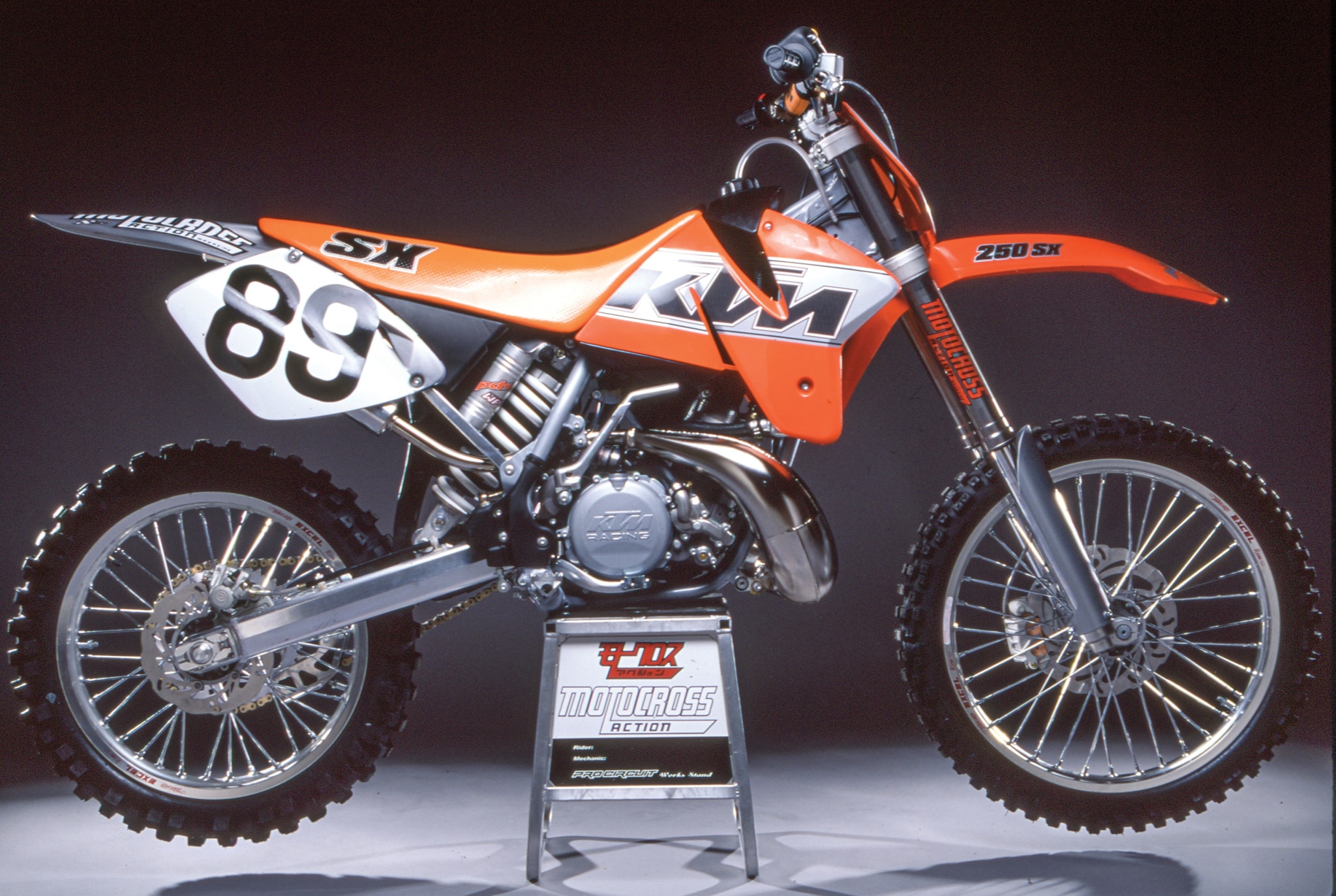
We get misty-eyed sometimes thinking about past bikes we loved and those that should remain forgotten. We take you on a trip down memory lane with bike tests that got filed away and disregarded in the MXA archives. We reminisce on a piece of moto history that has been resurrected. Here is MXA’s test of the 2000 KTM 250SX from the January 2000 issue.
Q: IS THE ’00 ENGINE FASTER THAN THE ’99?
A: Unfortunately, no. In truth, it’s not much faster than the KTM 125SX.
Q: WHAT’S WRONG WITH THE KTM 250SX ENGINE?
A: Just about everything. It has a lazy powerband that begs for an odometer and route chart. With the exception of a little burp of power when rolling the throttle on, there is not much to rave about. After the lively little hit, which is only really good for goosing the engine through the pits, the 250SX powerband delivers a short, flat, monotone style of power.
Q: WHAT DID KTM CHANGE ON THE 2000 ENGINE?
A: Everything! The most significant change was to the bore and stroke. KTM’s R&D department dropped the previous 67.5mm by 69.5mm bore and stroke for the more common 66.4mm by 72mm dimensions. This change alone necessitated new cases, a new cylinder, head, crankshaft, rod, piston, rings and pipe. While KTM was tossing out the old and ringing in the new, they made these changes:
(1) Increased the size of the water jacket (around the cylinder) to improve cooling.
(2) Shortened the connecting rod from 132mm to 129mm (rod length is not necessarily related to bore and stroke).
(3) Reduced crankshaft weight by inserting two tungsten inserts as stuffers.
(4) Cleaned up the reed intake channel to optimize fuel flow.
(5) Outfitted the engine with a Kokusan 2K4 ignition with a magnetic Power Jet solenoid to control the new 38mm Air Guide Keihin carb.
Q: WHAT DO THE CHANGES MEAN?
A: Sadly, very little. What is most surprising is that last year’s 250SX engine was a good piece. Although not blessed with stump-pulling low-end power, the 1999 250SX growled into a sharp, aggressive, crisp and hard-hitting midrange (with a pretty sweet over-rev).
So, why change it? Perhaps KTM felt that the ’99 engine had run its course and they needed something for the future; however, 12 months ago, KTM’s engineers had totally redesigned the 1999 250SX engine. Those changes included: (1) A newly designed reed block assembly. (2) A smaller exhaust port to increase spent gas velocity. (3) Lighter piston. (4) Narrower power-valve flapper. (5) Redesigned cylinder-head squish-band angle. And, (6) reduced crankshaft weight. Surprisingly, all that development work, which actually enhanced the powerband of the 1999 KTM, was thrown away in favor of a totally new engine. And, the results are dismal.
Q: IS IT AS FAST AS A JAPANESE 250?
A: No! At best, it’s as fast as a Japanese enduro bike. KTM should have sat on its new engine for another season of testing. Last year’s engine was twice as competitive as this year’s.
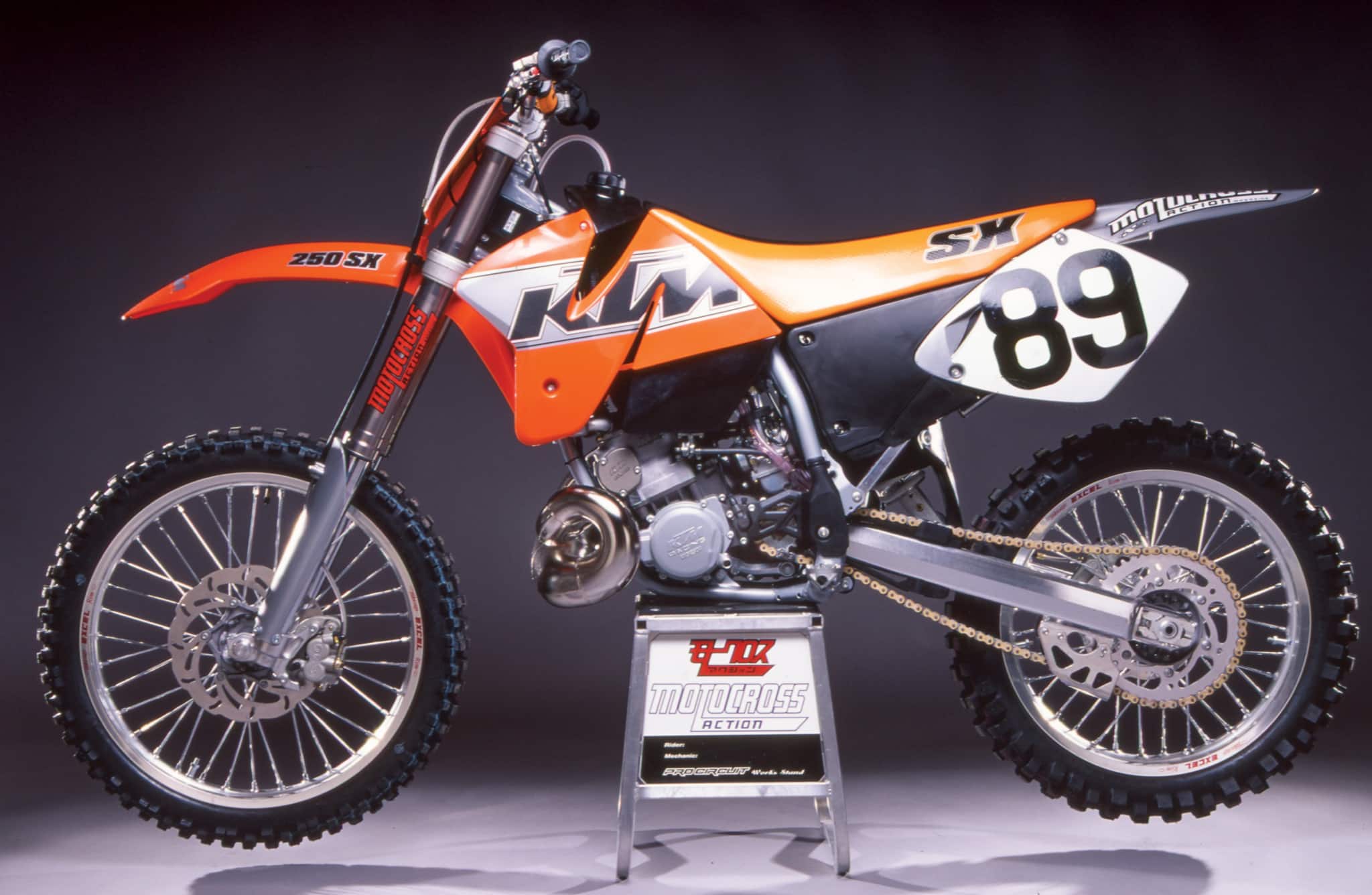
Q: WHAT ABOUT THE JETTING?
A: It pinged. It was hard for the MXA wrecking crew to imagine that an engine this mellow could detonate under a load, but it did (perhaps because it had to be ridden at 10/10ths all the time). Here is the jetting we ran in our KTM 250SX:
Main jet: 172
Pilot jet: 48
Needle: NOZF (NOZE)
Slide: 6.0
Air screw: 1.5 turns out
Clip: Groove number 3
Q: WHAT ABOUT THE HYDRAULIC CLUTCH?
A: The MXA test crew prefers hydraulic clutches to manual ones, but not for the reason you might think. If you imagine that hydraulic clutches are easier to pull than regular clutches, you are wrong. They aren’t. If you assume that they feel better than manual clutches, you are wrong. In truth, a hydraulic clutch is a little firmer than the smoothest of the standard clutches, and it has a distinctly different feel; however, the differences between an RM, YZ, KX and CR clutch pull are no less significant. What a hydraulic clutch does offer is a consistent feel over a long moto. It resists the temptation to go slack, get mushy or tighten up. Sweet, very sweet.
Q: WHAT ABOUT THE PDS REAR SUSPENSION?
A: KTM doesn’t use shock linkage, and, unlike everyone else on the planet, we don’t care. The whole idea of rising-rate, wishbone, rocker-arm, pull-link suspension systems is overblown. To achieve an effective rising rate, motorcycles don’t have to have complicated linkages. KTM understands this. By positioning the shock within the known framework of a scalene triangle (one in which the sides have different lengths and angles), a suspension designer can duplicate the rising rate of most linkage systems. And, if he’s a smart designer, he won’t duplicate the current crop of leverage ratios but aim for something with a straight rate. In truth, KTM has tried to do this, and they haven’t totally perfected it; however, they are a far sight closer than the Japanese engineers (who switch leverage ratios every other year—almost always returning to one they tried a few years before and then dropping it and moving on to the next magic but elusive number). It might sound strange, but don’t worry about the lack of rear shock linkage on the KTM.
What are the advantages of a single-sided, no-link, rear-suspension system? (1) Less complexity and fewer moving parts. (2) Future rising-rate changes can be accomplished by moving the lower shock position (rather than redesigning a complicated linkage). (3) Shock access is excellent. (4) The suspension becomes damping dependent instead of rate dependent. (5) The one-sided shock makes room for a straighter carburetor tract. (6) PDS suspension is 5 pounds lighter than linkage suspension.
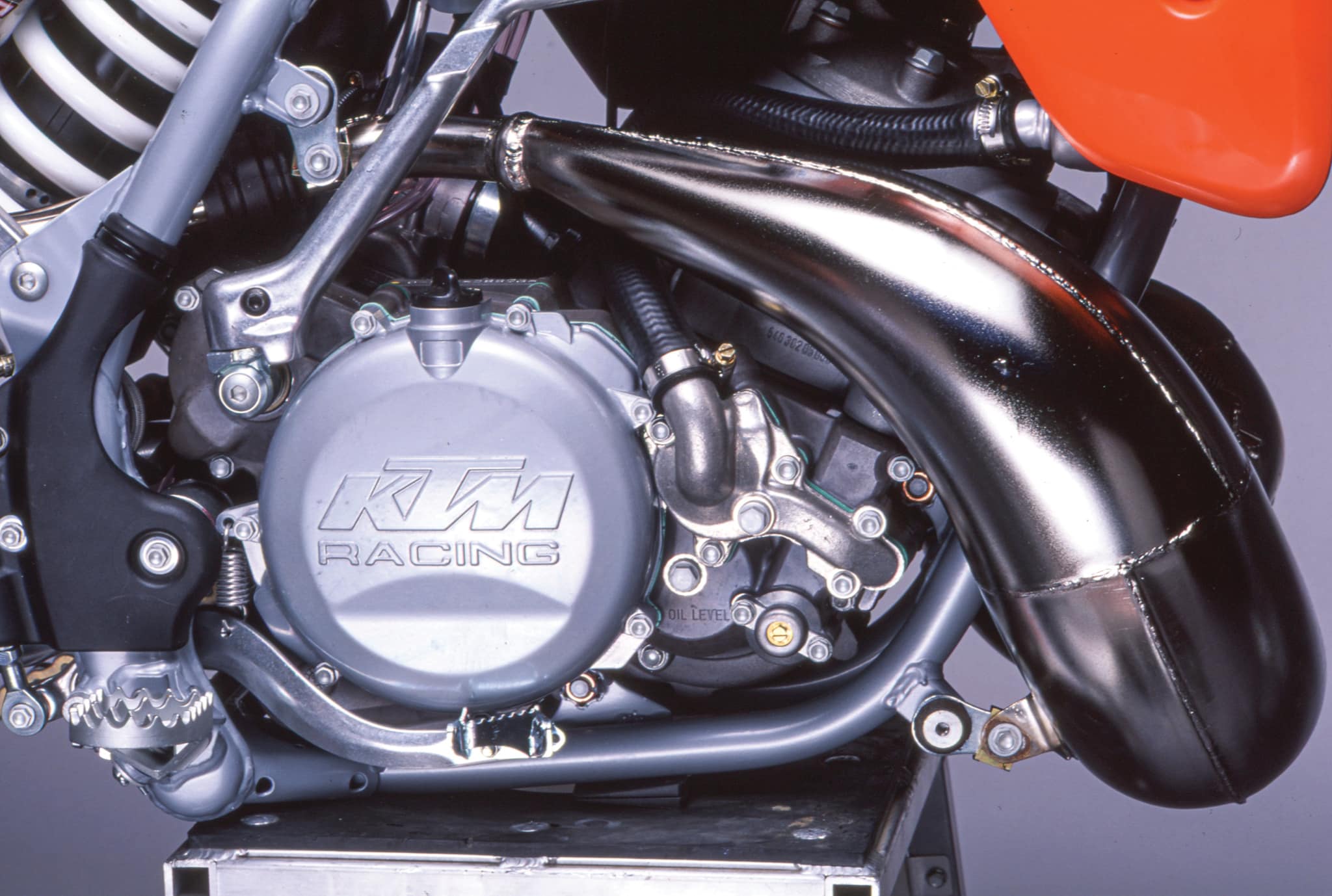
Q: HOW GOOD IS KTM’s NO-LINK PDS REAR SUSPENSION?
A: Much better than it was when KTM first adopted the idea. Outfitted with an Ohlins-conceived, dual-piston shock (licensed by WP), the KTM rear suspension is good. Since the complete system is damping dependent, as opposed to the Japanese method of altering the rising rate from year to year to try to induce improvement, KTM has made steady strides in dialing in the dual-piston shock. IT hasn’t always been perfected, but is can be with nothing more than a shock spring change
If there is one thing we would change, it is the stock progressive-rate shock spring. We’d opt for a straight rate. A straight-rate spring will stop the KTM’s tendency to drop into its stroke and bang around in mid-sized bumps. What was our best shock setting?
Spring rate: 8.3–11 kg/mm
Race sag: 95mm
Compression: 3 clicks out
Rebound: 20 clicks out
Notes: Common sense and years of experience tell a rider that turning the compression clicker in (clockwise) will stiffen the compression damping. Not so on a KTM. You turn the clicker out for more compression and in for less.
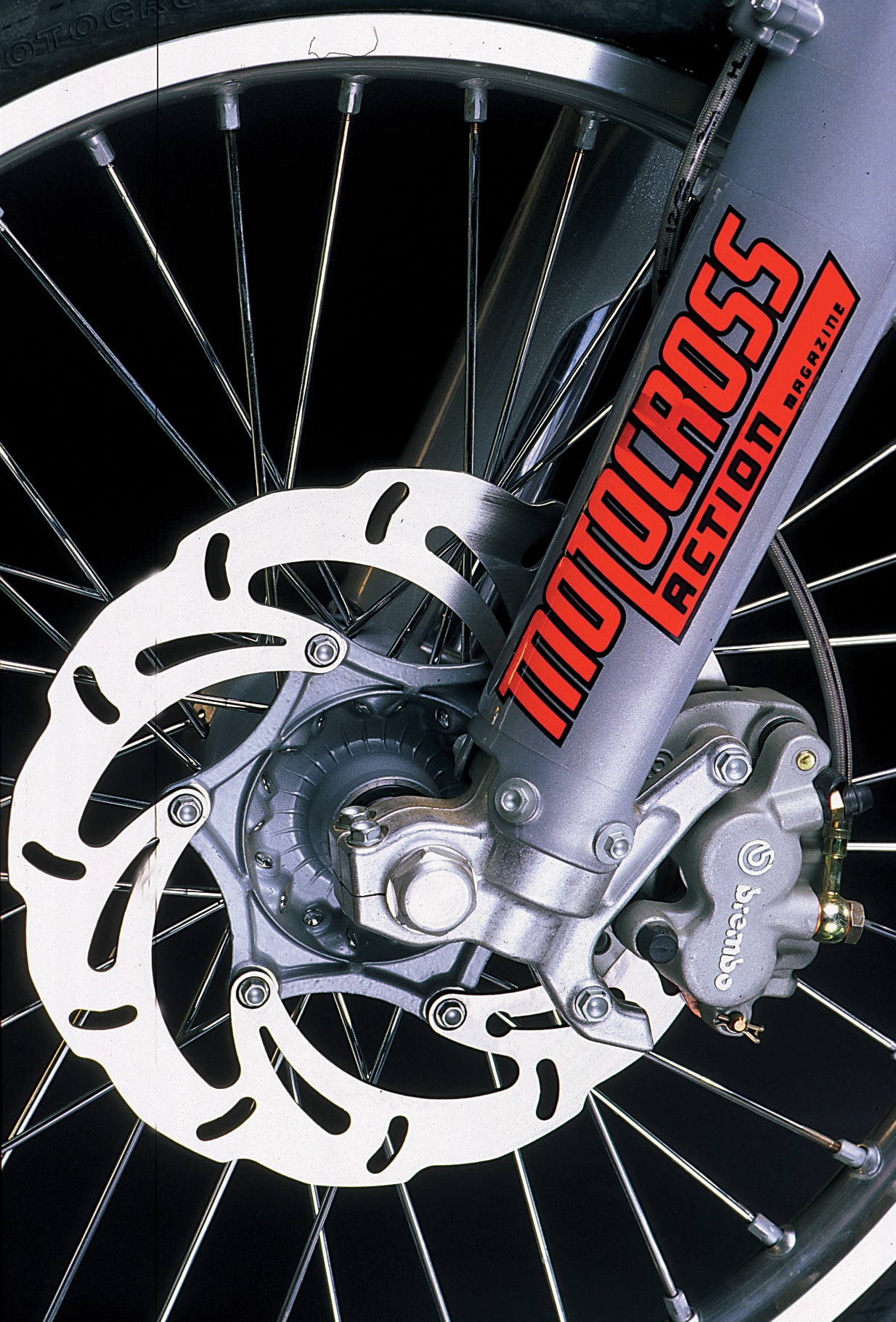
Q: WHAT DO WE THINK OF THE 2000 WP FORKS?
A: First, we are a little miffed that KTM threw in the towel on its 1999 right-side-up fork. That is a shame, because KTM’s 50mm conventional WP forks were winners. They were the best forks of 1999, hands down, but they are gone for 2000, replaced by 43mm, upside-down WP forks.
How good are the new forks? They are not as supple or responsive as last year’s forks, but they are still workman-like forks. The new forks feel harsh on low-speed compression and too quick in the mid-stroke, but they absorb hard landings well and are competitive with any other brand of fork offered in 2000. What was our best setting? For hardcore racing, we recommend this setup:
Spring rate: 0.40 kg/mm
Oil height: 140mm
Compression: 14 clicks out
Rebound: 14 clicks out
Fork height: 10mm above triple clamp
Notes: Unlike last year’s conventional forks, which had weird adjuster placement, the new WP upside-down forks mimic Kayabas (compression on the bottom and rebound on the top).
Q: WHY DID KTM SWITCH FROM RIGHT-SIDE-UP FORKS?
A: If KTM had the best forks in ’99, why did they switch to upside-down forks for ’00? Because of you. Not you personally, but the collective you. The great unwashed masses that make up the buying public want upside-down forks. The American consumer believes that upside-down forks work better than right-side-up forks. They are wrong (the Suzuki, Kawasaki and KTM both had better fork performance when they were right side up), but when it comes to laying down cold-hard cash, the customer is always right. Is there an advantage in KTM’s switch to upside-down forks? Yes. Upside-down forks are several pounds lighter than conventional forks.
Q: HOW DOES THE 2000 KTM 250SX HANDLE?
A: KTM handling is an area that can’t be danced around. The Austrian bike does not handle like a Japanese motocross bike. This is most noticeable on tight, twisty tracks, but it is equally evident in any sharp corner. It doesn’t turn as quickly as an RM, YZ, CR or KX. And, with its enduro powerband, it’s best not to dive into the inside and try to drag race your competition out of a turn. Better to slide the corners, seek the outside line and try to maintain momentum.
There is something intrinsically strange about the first few minutes on a KTM chassis (although, we don’t feel the same way about the smaller, lighter and more agile KTM 125SX). The 250SX feels different—not wrong, not bad, not awkward, just different. After about 30 minutes of riding, the out-of-sorts sensation goes away, and the balance points become more natural. Even if it’s not as quick on the inside as its competition, it really shines at high speed. It’s a very stable platform.
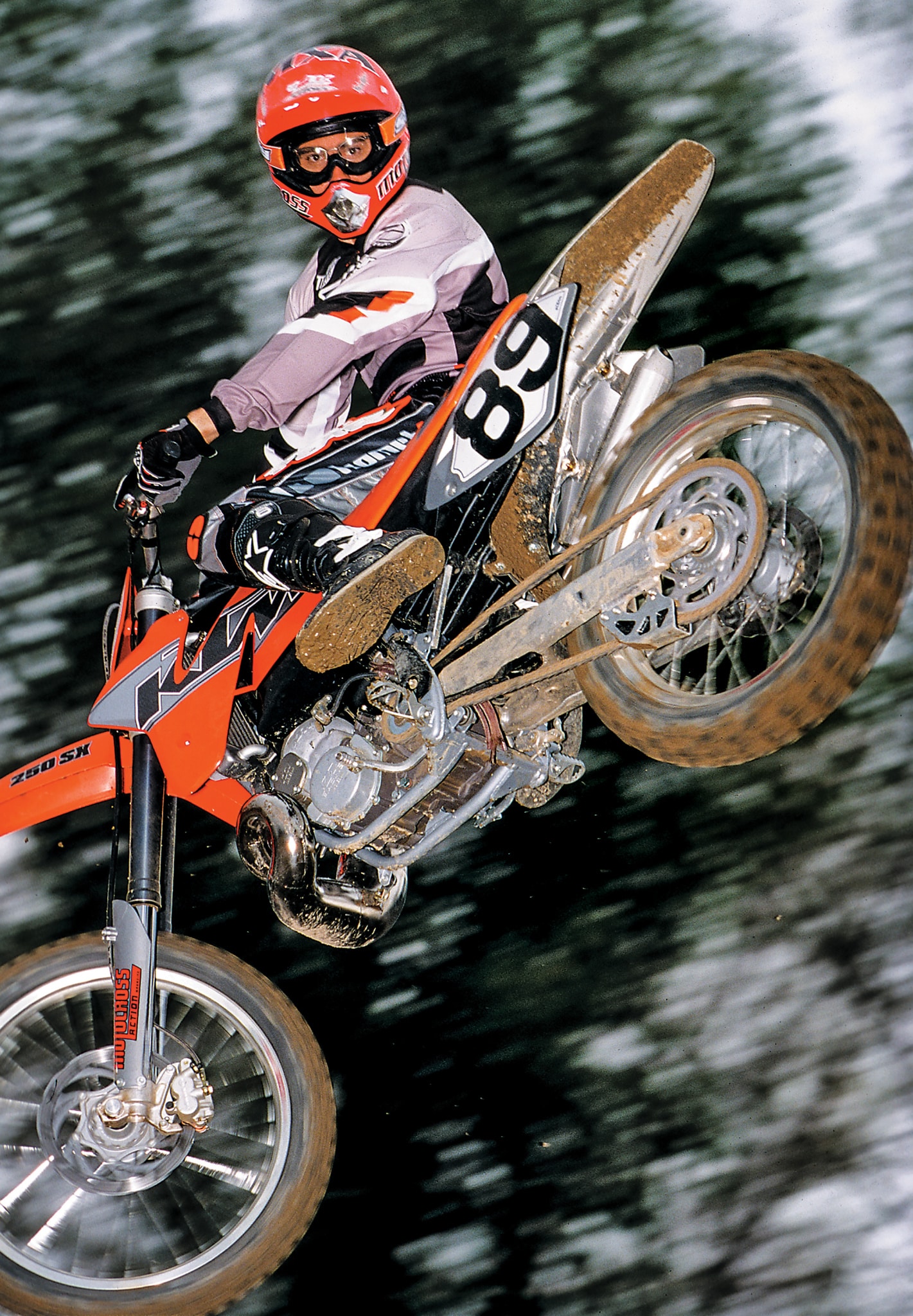
Q: WHAT DID WE HATE?
A: The hate list:
(1) Color. We have grown to like the orange, but we will need a few more years to dull our aesthetic tastes to the point where we can accept the silver side panels, rear fender and fork guards.
(2) Front fender. KTM’s front fender looks awful. Whoever came up with its forked-tongue design deserves a promotion … to any KTM division outside of the design department.
(3) Gas cap. The gas cap is too small.
(4) Radiator wing. The rear corner of the radiator wings hooks on your leathers. The quick fix is to trim the very back edge (where the seat and tank meet) so that the radiator shroud has a rounded corner.
(5) Side panels. When the aftermarket designers start offering trapezoid-shaped digits, the KTM side panels will be in vogue. Until then, no matter how you angle the numbers, it’s wrong.
(6) Shock bolt. If you are standing by a track when a KTM 250SX goes by, look down at the ground. Most likely you will find the bike’s top shock bolt.
(7) Silencer. We have lost enough KTM silencer end caps to stock a dealership. Take our word for it—tighten the sand-cast end cap before every race.
(8) Exhaust pipe. KTM might be suffering a bout of oxygen embrittlement on its exhaust pipes. We saw two pipes that cracked at the bottom exhaust-pipe spring. Since the KTM has three springs, we removed the bottom one and didn’t suffer a failure.
(9) Clutch lever. KTM spec’ed a diminutive, two-finger, clutch lever for 2000. It’s too small. Luckily, last year’s full-size clutch lever fits.
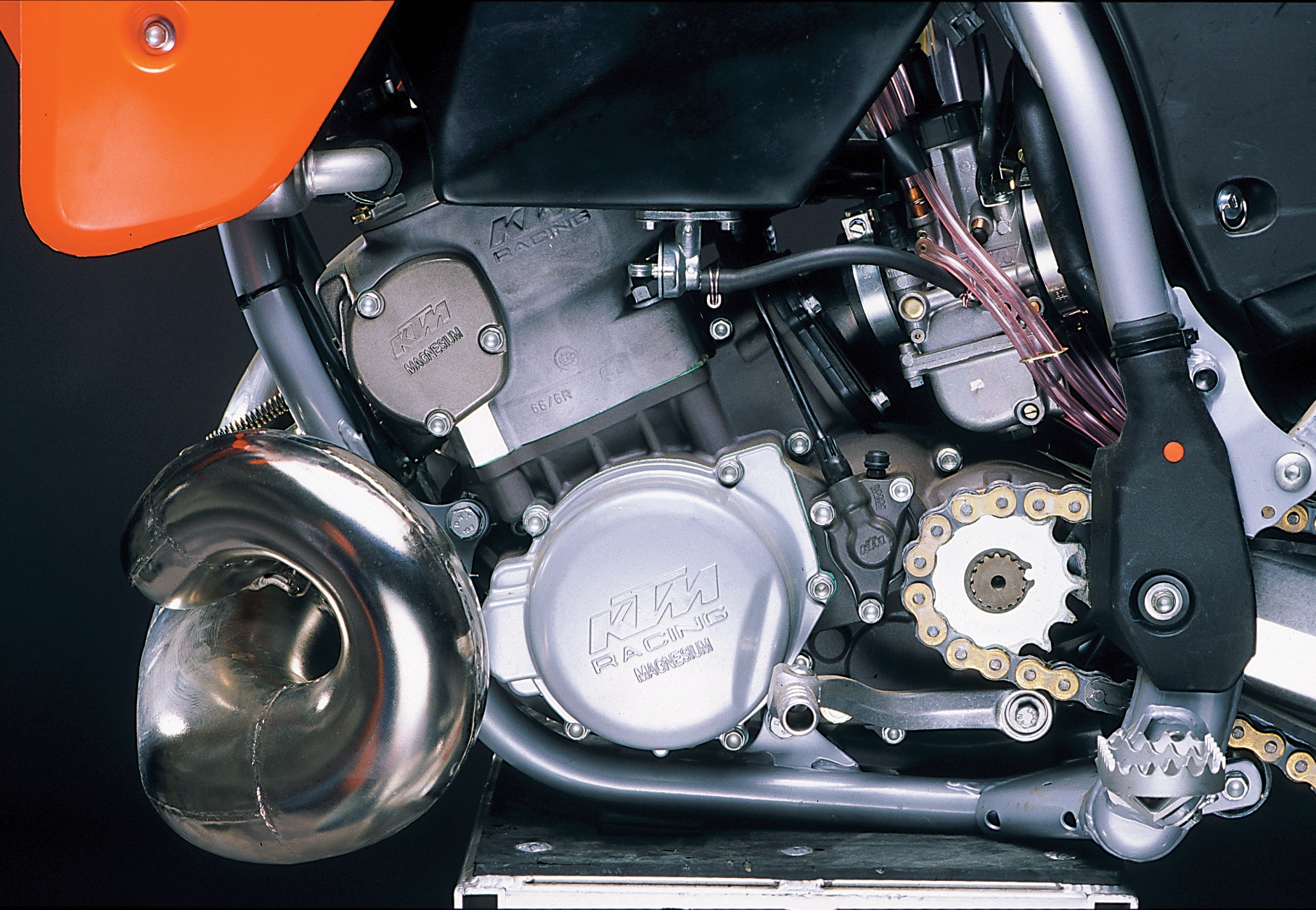
Q: WHAT DID WE LIKE?
A: The like list:
(1) Airbox. KTM’s no-tools-needed airbox could use a touch more engineering, but it’s cool not to have to remove the seat to get to the filter. Watch the Dzus-style fasteners. They disappear faster than pens at sign-up.
(2) Handlebars. The KTM is the only one of the Big Five to come stock with aluminum handlebars. Very cool.
(3) Tires. Bridgestone M77/78s are good intermediate-terrain tires. We like this sneaker combo (although, we like the rear more than the front).
(4) Frame guards. KTM includes plastic frame guards on every bike.
(5) Brakes. What a difference! Finally, KTM has addressed its brake problems. Thanks to a new front master cylinder, smaller-diameter hydraulic line and new rotor, the front brakes are one-finger powerful. Even better, KTM put a larger piston in the rear master cylinder to cut down on hydraulic pressure in the line. The result? The brake can no longer be used to turn lights on and off. Better modulation and less lock-up are long overdue.
(6) Preload ring. Instead of using two rings, which lock against each other, KTM uses a very thick single ring that clamps to the shock body via an Allen bolt. This is a good idea and makes adjusting spring preload easier.
(7) Clutch. It’s hydraulic. Enough said.
(8) Chain adjuster. KTM designed eccentric chain-adjuster blocks that can be turned around when the chain stretches. Additionally, they have a very long axle slot to accommodate massive wheelbase changes.
(9) Bar mounts. KTM’s new triple clamp features adjustable bar mounts. This allows the rider to fine-tune the fit. We ran the bars all the way forward.
Q: WHAT DO WE REALLY THINK?
A: What do we think? We don’t think the new engine is ready for prime time. If the 2000 KTM 250SX came with the 1999 engine, it would be a runaway hit. As is, it is a disappointment.




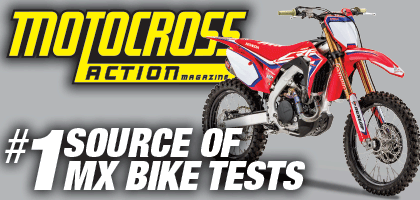


Comments are closed.